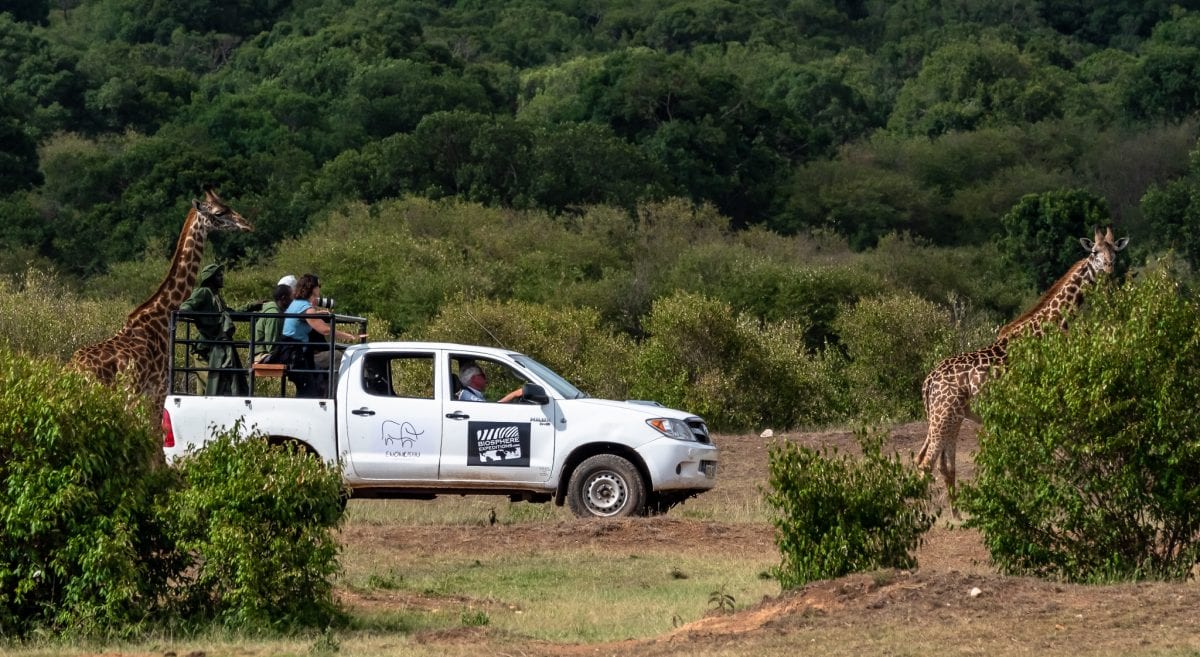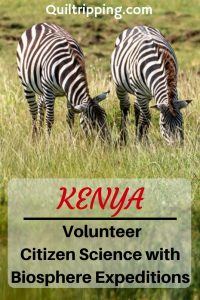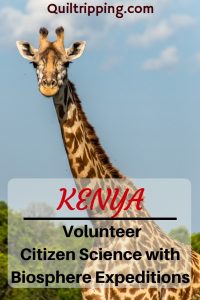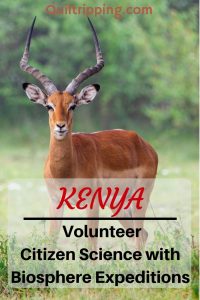Last Updated on 07/01/23 by Rose Palmer
I have heard it said that Africa gets under your skin. I certainly found that to be the case after my safari to Kenya and Tanzania last summer. So, I jumped at the chance for a press spot as a volunteer citizen scientist in the inaugural Biosphere Expeditions program in the Maasai Mara in Kenya. I am sharing my wildlife conservation volunteer travel experience to inspire your next adventure to Kenya.
Biosphere Expeditions is a non-profit organization that provides volunteer citizen-science expeditions which empower ordinary people to make a difference in the field of wildlife conservation.
This inaugural program in the Maasai Mara ecosystem took place in the Enonkishu Conservancy which is called the “last line of defense”: on one side of Enonkishu the land is completely developed for agriculture and cattle grazing; on the other side are fully protected conservancies and the Maasai Mara Reserve. The fledgling Enonkishu Conservancy is working on finding the optimal balance between the needs of the traditional Maasai cattle herders and the needs of the East African wildlife. As volunteer citizen scientists, our group would help collect the data needed to manage and maintain that balance.

During the 12-day Biosphere Expeditions program, I posted a daily dairy of my activities on my Facebook page, which I am sharing here (along with much more additional information). Warning – this is a very long post.
My Wildlife Conservation Volunteer Travel Experience in Kenya
Day 1 with Biosphere Expeditions Kenya – Sunday Feb. 17
Temperature – high 86F, low 54F; partly cloudy.
After two days of flying and a little over half a day of driving (with a day off for sightseeing in Nairobi), I finally arrived at the Mara Training Center in the Enonkishu Conservancy in Kenya.

I am one of twelve intrepid souls that have come from all over the globe on a volunteer holiday. We are here to work as citizen scientists to help trail blaze this new program, collecting data under a variety of conditions to quantify and document the biodiversity in the greater Mara ecosystem.
Today was all about getting here, getting settled and introductions. Our drive from Nairobi was about 5 and a half hours. The first four hours were in a large comfortable bus. As we left Nairobi, we started climbing the eastern ridge of the Great Rift Valley and for a little while, had great views looking down into this expansive scenery that was the cradle of the human species.
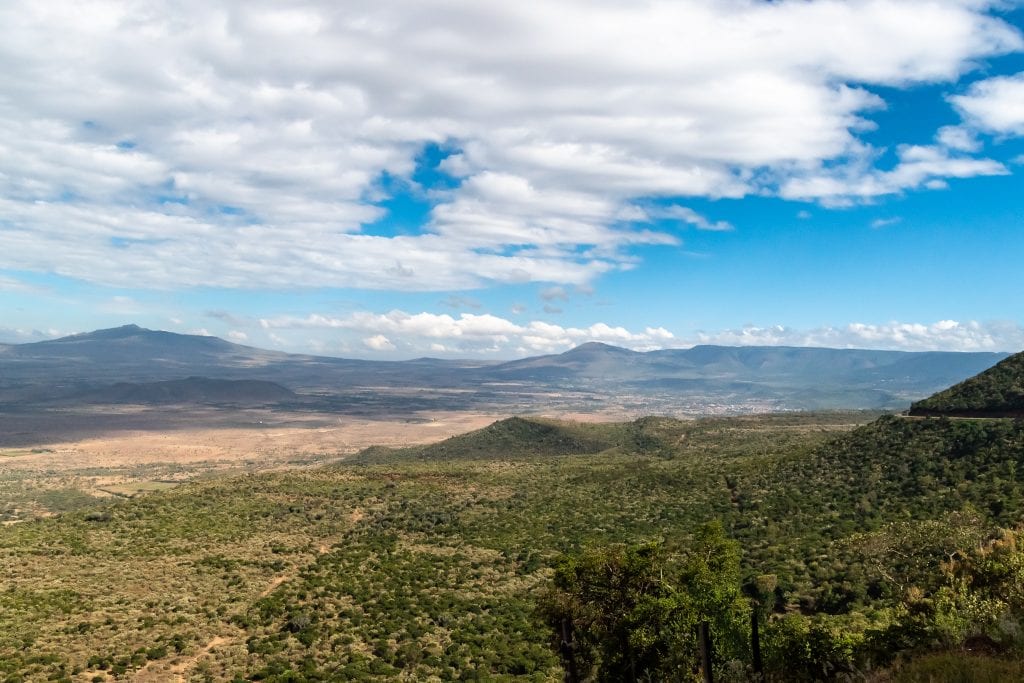
We descended into the valley and continued our drive west toward the town of Narok. On the way we passed freshly plowed fields, herders with their cattle, goats and sheep, and many small, colorful villages with shops and markets.

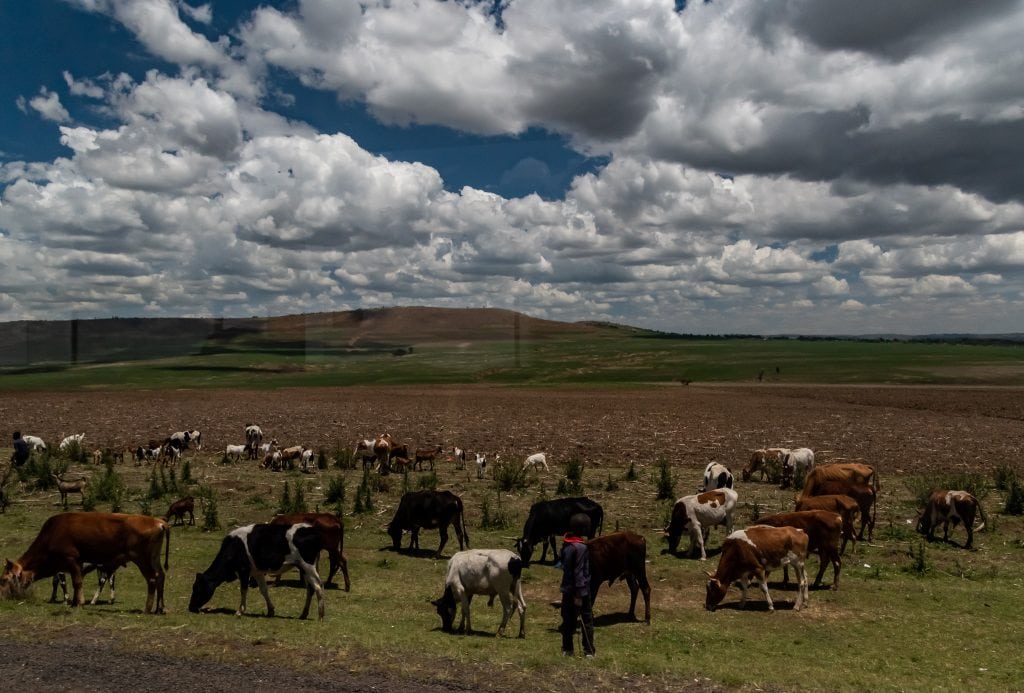

In Narok, we made a brief pit stop at a small mall that was not that much different than those at home, except for a security check before going in. I went into the supermarket to pick up drinks and snacks. The labels and packaging were unfamiliar, but otherwise, it was not that different from my local grocery store.
Another 40 minutes and we reached the intersection where our drive took us off the paved road and onto the dirt road that would take us into the Mara conservancy lands. We switched vehicles to 4×4 trucks and then bounced for another hour along a rough dirt road to our new home.

After a vegetarian lunch, our program started with introductions of each other and an overview introduction of the program and its goals. Our group demographic is quite diverse, representing the US, Canada, the UK, Australia and a local Kenyan intern. We have five men and seven women with ages ranging from 30’s to 70’s. Backgrounds and skill sets are equally diverse: an emergency room doctor, an English teacher, nurses, a writer. Regardless of their background, each person is here because of their passion for wanting to make a difference.
We started the program training with a risk assessment and a review of safety protocols – everything from dealing with insects, diseases and weather, to how to behave around wild animals. The information was basic common sense, like putting on bug deterrent and sunscreen, wearing a hat, drinking plenty of water, and listening to the rangers with regard to wild animal behavior. But it was good to review the information and be reminded that we are ultimately responsible for ourselves and those around us.

This will be my home for the next 12 nights. My accommodations are surprisingly comfortable – better than many scout camps I have endured in my time. I have a single tent with a double bed and nice linens and blanket. For those of us in tents, there is a nearby building with hot showers and toilets.

For those that are traveling with a friend or don’t mind sharing, there are also “bandas” – brick buildings with mesh and tent-like windows and doors. The bandas have two beds and an en suite bathroom with hot showers and toilets. And since this is a training center for the area, we have both electricity (most of the time) and WiFi.


Day 2 with Biosphere Expeditions Kenya – Monday, Feb. 18
Temperature – high 79F, low 54F; sunny in the AM then clouds and rain in the evening.

Today was all about training and learning how to collect data accurately and consistently across all twelve of us. We spent the morning in the (very nice) training center, learning how and what to record on the data sheets and learning how to use the tools of the trade: walkie talkies to stay in touch, range finders to measure distance to the animals, GPS to measure exact latitude and longitude and a compass to measure the angle to the animal sighting. And finally, how to use the scat kit. I think this is my first and only training that included samples of animal poop as part of the training supplies.

After lunch, it was all about driving safety and vehicle maintenance – specifically, how to change a tire on a 4×4 truck (not easy and definitely not one of my skills). The roads in the conservancy are pretty rough and bumpy and the off road trails are potentially worse, especially after it rains. The trucks are manual transmission, but even for many of the experienced drivers, driving these trucks was still a challenge initially since the steering wheel and the gear shift are on the right (British) side of the vehicle.

Then it was finally time to supplement the classroom lessons with drives out into the conservancy land. We quickly left behind the plowed farm lands and entered what was clearly wilder terrain. We had barely started driving when we were greeted by four beautiful and graceful giraffes. Then we saw zebra, and wildebeest and warthogs and Thomson’s gazelle, and eland and, and, and………Over the course of the next three hours we stopped every few minutes to identify and record every single animal in our path.


And today was just a practice run-tomorrow the real work begins.

Day 3 with Biosphere Expeditions Kenya – Tuesday, Feb. 19
Temperature – high 74F, low 52F; cloudy with intermittent afternoon showers.

We spent the morning putting into practice what we have learned so far. We divided up into four groups and each one drove a predetermined path, called a transect, across the Enonkishu conservancy. When we spotted an animal, we stopped and recorded the time of the observation, the type of animal and how many, the distance using a rangefinder, the GPS coordinates and the angle to the animal using a compass. We also had a conservancy ranger with us who was instrumental in helping to identify if the animal was a male, female or juvenile. At many stops, there was more than one species, so we would record all of this data for each type of animal we encountered. It was not uncommon to see three, four or more species in one location, grazing peacefully together.


The initial part of my group’s transect passed through open grassland scattered with trees and bushes. This is where we saw the greatest variety: zebras, impalas, warthogs, giraffes, wildebeests and Thomson’s gazelles. Once our transect moved into more densely forested terrain, we did not see very much wildlife any more. The forest is good elephant habitat, and there is a herd roaming the conservancy, but we did not see them. We did see signs that at least one or two elephants had passed by recently – very fresh and very large poop piles were scattered across the road.

Once we got back home to the training center, all the data we had collected were entered into a computer. Then it was time for lunch and a short break.
For the afternoon, we split up into four groups again. This time our task was to find the camera traps that had been set out throughout the whole conservancy, change the batteries and the SD cards, and reprogram. Since we would be walking to the cameras, we also had a ranger along. For my group at least, the hardest part of this was finding the exact tree where the camera trap had been posted, even though we had the GPS coordinates.


We finished off the afternoon with a stop at the waterhole observation spot with a quick training session on where and how to collect the data from the hide set up there.
Another good day in Kenya.
Day 4 with Biosphere Expeditions Kenya – Wednesday, Feb. 20
Temperature – high 72F, low 54F; sunny, beautiful sunrise with a full moonset; clouds in the afternoon.
The morning started out with a beautiful sunrise complimented by the full moon as it was setting.
Our days are now developing into a rigidly structured routine:
- 6:00 AM breakfast
- 6:45 AM leave for morning animal sighting activity
- 11:00 AM return from morning activity – clean up, enter data
- 12:00 briefing
- 12:30 PM lunch
- 3:00 PM leave for afternoon animal sighting activity
- 7:00 PM return from afternoon activity-clean up, enter data
- 7:30 PM dinner
- Optional night time animal sighting drive
I am still feeling the effects of jet lag, so I got some much needed extra sleep this morning and then used the rest of my morning time to catch up on data entry from previous sightings. I am all too familiar with this less glamorous but highly critical aspect of science.
I also took a peek at the SD cards that our group recovered from the camera traps and was excited to see a night time leopard photo capture.

For my afternoon activity I chose to do the waterhole observation. I was not sure what to expect – it could be very dull sitting for four hours with nothing to see, or it could be exciting watching a slew of animals interacting with each other.
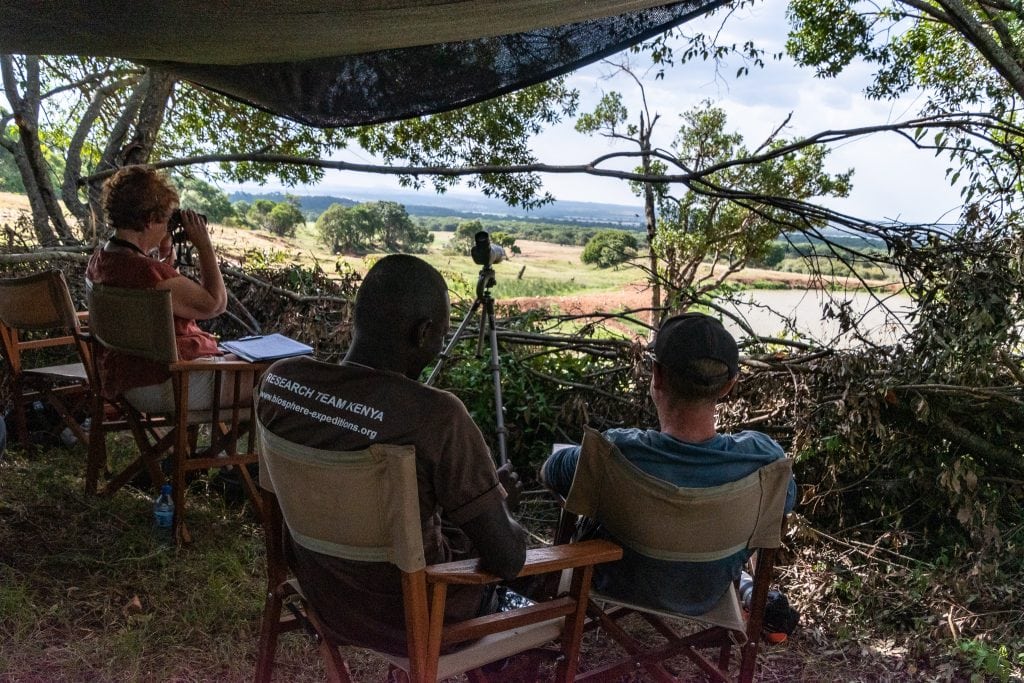
The reality was somewhere in between. The waterhole overlooks a grassy plain that had zebra, impala, giraffes and warthogs grazing on it. At one point, a male zebra and his female harem did come directly to the waterhole’s edge for a drink. Also, every once in a while, the resident hippo would poke his snout out of the water.
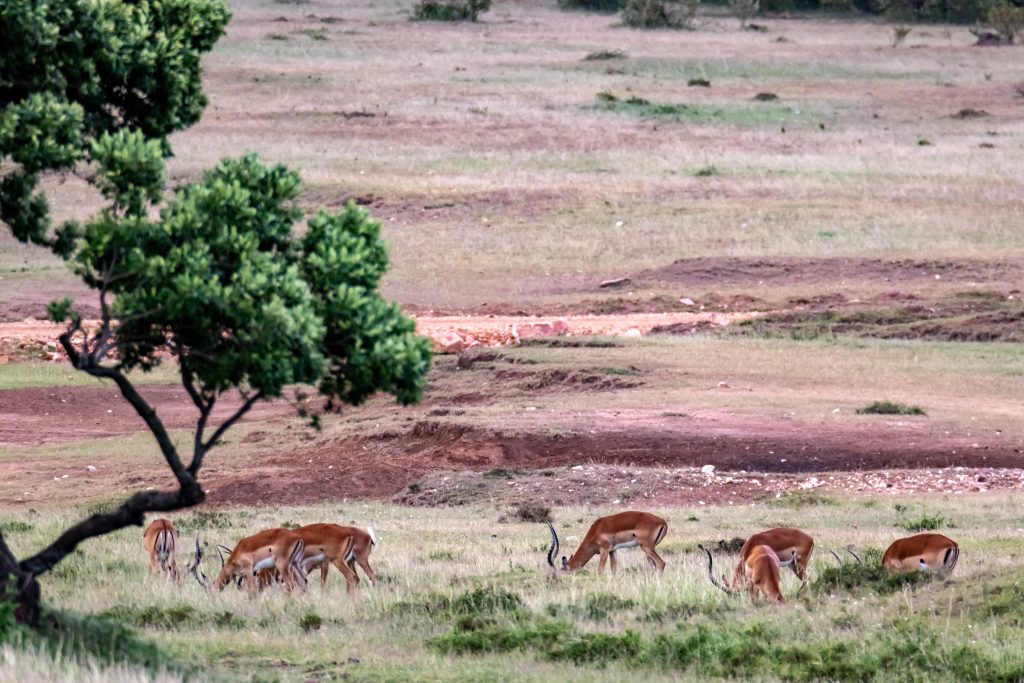
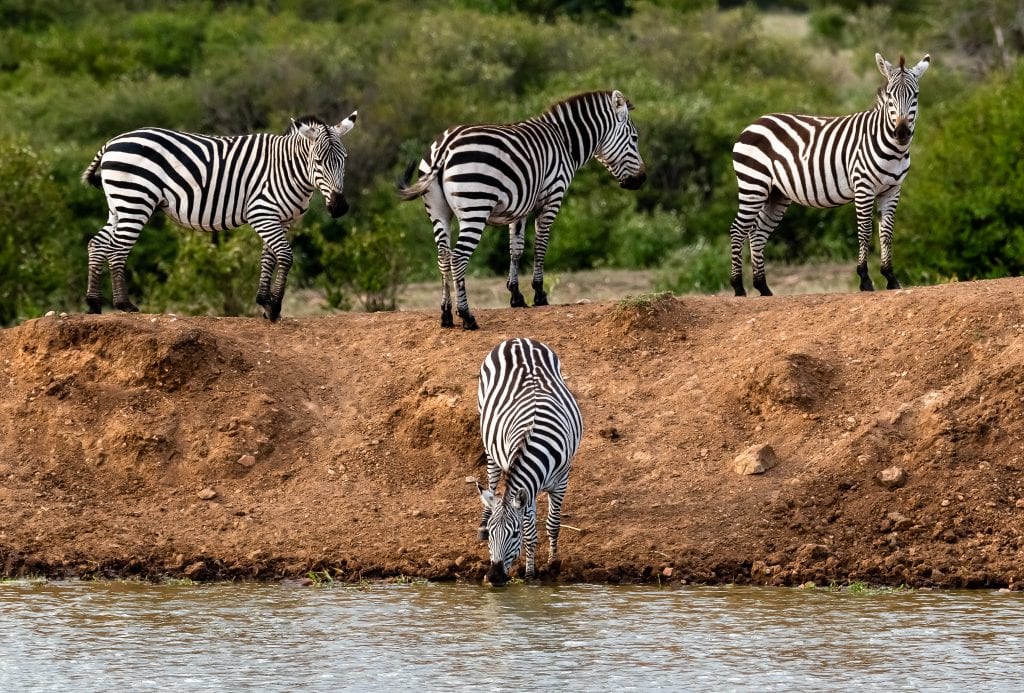

Tomorrow I’ll be trying out some of the other wildlife sighting activities.
Day 5 with Biosphere Expeditions Kenya – Thursday, Feb. 21
Temperature – high 78F, low 53F; sunny.
For the first time this morning, I walked where zebra, impala and elephants also tread. It is thrilling to be on the back of a truck and see the African wildlife all around you. But to be walking at their level is a totally different immersive experience.

We walked through a green park-like setting where the grass was kept clipped by the zebras and impalas that greeted us. While we only got to within a few hundred feet of them, seeing them at eye level reminded me that I was the interloper in their land.

We then walked through a lowland forest where the elephants like to eat. At one point, the rangers with us showed us the skeletal remains of the last poached elephant in the Enonkishu conservancy – a sight that was equally sad and triumphant. No other elephants have been lost here since this one in 2016.

But this was not just a stroll in the park – we were here to also collect data. When we spotted an animal, we did the data record keeping that is now becoming second nature – time of sighting, distance, angle, GPS coordinates, and total animal count. (Full disclosure – the rangers did all this for practice, and I just got to enjoy my surroundings).

We also stopped to look at animal tracks and animal poop (scat to be technical) – from the tiny diik-dik tracks to the large giraffe and elephant tracks.
Throughout the walk, my local Maasai companions continued to astound me with their knowledge of both the fauna and the flora. While the rangers may have had to learn all their animal knowledge as part of their job, their knowledge of the local plants and shrubs are part of their Maasai cultural heritage. It seemed like each bush that we passed had leaves that were good for treating one ailment or another.
I also learned more about what it is like to be a ranger as I chatted with head ranger Dapash. I learned that the rangers have an app on their phones that allows them to record wildlife sightings as well as infractions and poaching incidents. Now I understood why Kenya had such good cell service, even out in the wilderness.
I spent the afternoon on another driving transect across the grassy plain of the Enonkishu Conservancy. It was impressive to see a land that had once been barren due to cattle overgrazing covered in green grass and a large variety of ungulates. It’s a testament to Mother Nature’s resilience, as long as we give her the help she needs.

The breeze was blowing, the sun was shining, and I think I fell in love with Kenya all over again.
Day 6 with Biosphere Expeditions Kenya – Friday, Feb. 22
Temperature – high 78F, low 54F; sunny, afternoon clouds.
Today was an absolutely glorious day – the kind of day that you dream about when you think of Kenya. This was our day off from volunteer data gathering, and we had a few choices for excursions if we wanted to do one. I opted for a traditional game drive in the neighboring conservancies which border the Maasai Mara Reserve and Enonkishu. We got an early morning 6:30 AM start and spent 12 hours exploring the land, as well as connecting with one of the local Maasai villages.
The Enonkishu Conservancy is still in the process of growing into its full conservancy potential and has made great strides in that direction. As we drove through the neighboring Olchoro and Lemek Conservancy lands, we saw the classic Maasai Mara landscape that we have come to expect – expansive vistas of grassy plains covered with all variety of ungulates. We had already become familiar with many of these in our work with Biospheres Expeditions, but here, it was the quantity of animals that was astounding.

Midday, we stopped at one of the local Maasai villages where we were greeted with huge welcoming smiles and gracious hospitality. The villagers demonstrated some of their traditional dancing and then took us into their homes and explained their daily lifestyle. We ended the visit with an opportunity to purchase some of the beautiful handmade crafts that the Maasai are known for.
Lunch was a picnic under a large tree by the Mara river with a serenade of grunts from a chorus of over a hundred hippos, followed by more game driving.
What made this day particularly memorable were the predators that we saw up close and personal. A hyena taking a break in the shade of a bush. A jackal feasting on a recent kill.
And the icing – three separate sightings of lions, including two females and their three cubs. In each case, the lions were no more than 10 to 15 feet away and were completely unperturbed by our presence. They were sleeping en-masse in the shade and couldn’t have cared less that we wanted photos of impressive king-of-the-beast behavior. We watched them all for a long time, and I came to the conclusion that they were basically all just overgrown kitty cats. They scratched, they rolled, and they lay on their backs with legs up and bellies exposed. And then they yawned and showed their large teeth, and there was no doubt that they were at the top of the food chain.
The day ended on a high as we came across two sister lionesses and their three cubs. Initially they were sleeping in the shade also, but then they all moved out into the open grass, only feet away from our vehicles. We learned that both females will nurse and take care of all the young together, and we saw that in action as the two month old cubs went from one sister to another to eat. We sat there entranced for almost an hour, watching this young family interact. Such a truly memorable and awe inspiring experience.
Day 7 with Biosphere Expeditions Kenya – Saturday, Feb. 23
Temperature – high 65F, low 53F; cloudy, raining and thunderstorms.
Today has been an inadvertently quiet day. As a group, we started a 72 hour continuous observation study at one of the waterholes. Teams of two will be observing and recording wildlife from a blind in four hour shift intervals. Each one of us signed up for a morning, afternoon and evening/night shift. My first shift does not start till tomorrow afternoon, so I signed up for other activities today.
I spent most of the morning reviewing one of the camera trap SD cards, looking for unique wildlife and interesting behavior. I was rewarded with a 10 second video glimpse of a leopard captured by the camera during one of the nights.
In the early afternoon, the clouds opened up and we had a tremendous thunderstorm-a foreshadowing of the rainy season, I think. As a result, the planned afternoon observation drives were canceled, which gave me the time to have a very interesting conversation with our Kenyan intern about the Maasai culture.

Days 8 and 9 with Biosphere Expeditions Kenya – Sunday, Feb. 24 and Monday, Feb. 25
Temperature – high 69F, low 52 F; cloudy with intermittent sun and scattered rain and thunderstorms in the afternoons.
For me, these two days have been all about collecting data for the 72 hour waterhole study. We each signed up for a morning, afternoon and an evening/night shift. During the shift, each team of two would do an animal count at 15 minute intervals and record the numbers. We were also on the lookout for interesting behavior and recorded that as well.
My first turn was on Sunday from 4PM to 8PM, then early Monday morning from 4AM to 8AM and Monday afternoon from 12 noon to 4PM. This schedule gave me the chance to get a snapshot in time of the activity in the area around the waterhole during all parts of the day. The view from our hide extended for many hundreds of yards across woods and grassland beyond the waterhole, so we were able to see the grazing animals as they moved from one spot to another for food.

During my shifts, I only had one sighting of giraffes coming down to the waterhole itself. It was a mom with her young and I had the opportunity to watch the baby twist its neck like an Olympic gymnast so that it could nurse. Throughout the daylight hours, I saw many zebras, giraffe, impala, Thomson’s gazelle, wildebeast, and water buffalo in the grassy plains around us as well as the local hippo that made his home in the pond. Occasionally, a hyena or jackal was seen running in the distance. And of course, quite a variety of birds of all sizes.
I never tired of watching the giraffes – next to elephants they are my favorite animal. While most of the wildlife didn’t see us or did not care, it was obvious that the giraffes knew where we were, that we were looking at them and they were quite curious about us. They would stand there, head and neck held erect, ears up, looking straight into our eyes for 5, 10 minutes at a stretch. Then, when their curiosity was satisfied, they moved on, walking slowly, almost as if in slow motion, and coordinating their long necks and legs into a graceful ballet.

Once the sun set, our visibility was obviously more limited. We used red, green and infrared flashlights, and an ambient light enhancer (night sight) to scan around the waterhole for signs of life and specifically for two bright spots as our lights reflected off animal eyes. During my nighttime shift, we did not observe anything while it was dark – a great reminder that in science a data point that is zero is still data and is not the same as no data. A few of the other teams did get brief glimpses of a leopard during their night shift, but I was not that lucky. That does not mean that there were no signs of life during the night. We were serenaded quite loudly by a chorus of toads, frogs and insects, with an occasional solo by a barking hyena, and then, as dawn came, the birds took over the concert. When the sun appeared above the trees, so did the grazers, and another day started its cycle in the conservancy.

During the daylight hours, it was fascinating to watch Mother Nature’s choreography as the various individual animals and groups moved around from one spot to another in search of food and water. Occasionally, there were some interesting social behaviors. At one point a warthog came running directly at another warthog that was near us and I thought for sure there would be a fight. Instead, they surprised me by greeting each other with nuzzles. On another occasion, as the giraffes were watching us intently, one of them bent down and curled its head and neck around the neck of the giraffe next to it – a behavior that it did a number of times.
The four hour shifts went by surprisingly quickly, even during the darkest part of the night shift. Fifteen minutes is not a long time – we would do a scan and record the data, and then again another fifteen minutes later, and another, and before we knew it, the shift was over and it was time to go back to the training center for food, drinks, or sleep, and data entry.
I really enjoyed taking part in the waterhole observation study. Yes, there were periods of boredom, but that was more than compensated for by the periods when I got to be a voyeur, observing the animals in their natural habitat as they went about their daily life. Not to mention one of the most colorful sunsets I have ever seen.
Day 10 with Biosphere Expeditions in Kenya – Tues. Feb. 26
Temperature – high 76F, low 53F; sunny and clear.
Today was all about catching up. The greater group finished the 72 hour waterhole observation study at noon. I used the morning to catch up on sleep, catch up on writing and some photo editing, and catch up on data entry.
In the afternoon we reviewed the waterhole observation study and then planned activities for the environmental education day that we would be doing with local students tomorrow.
The evening ended with another truly unique experience for me – a general game observation drive through the Enonkishu Conservancy at night. Driving at night became a completely new experience. Tracks that had become familiar during the day, now took on a whole new unrecognizable perspective. Yet, for the rangers that accompanied us, the landscape was nothing more than “a walk in the park”. Our visibility was limited to what we could see in the truck headlights and with our red and green flashlights. We scanned across the grassland, looking for two yellow reflective eyes which meant signs of animal life (and all of us secretly hoping to see the elusive leopard). In general, it was a quiet wildlife observation night, though we did see a few new species: springhares, African hares, whitetail mongoose and a giraffe that was unexpectedly sitting on the ground.
At one point, we stopped the truck in the middle of the grassy plain, turned off all the lights and contemplated the universe above us. It was a perfectly clear night and we had 180 degree views of the sky in all directions without any light pollution – a sight that is never possible on the east coast of the US where I live. The milky way stretched across the sky from north to south and about a gazillion stars were visible all above me – if I reached up, it felt like I could almost touch the stars. Truly an amazing sight. Back at camp, the milky way was visible in the clear sky over our tents as well.
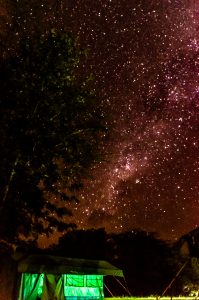
Day 11 with Biosphere Expeditions Kenya – Wednesday, Feb. 27
Temperature – high 79F low 53F; sunny and clear.
Our day today was all about sharing our passion for conservation and the wildlife we have been seeing for the past ten days with a group of local school students. Early in the morning we crossed the Mara river and drove about a mile to the nearby Emarti Secondary School. We were greeted warmly by the deputy principal who proudly showed us around the grounds. As with many of the schools in Kenya, this is a boarding school where the children live full time for nine months of the year.
We then met up with 19 students that belonged to the school’s Wildlife Club and headed off into the Enonkishu Conservancy for a game drive. We showed them how we had been collecting data and how to use the compass, rangefinder and GPS. When we saw an animal, they eagerly practiced with these tools. It was heartwarming to see how enthusiastic they were at each animal sighting, of which we had many. It was almost as if the wildlife knew they were being shown off and they all came out to be admired. There were herds of impalas and zebras, families of warthogs and giraffes, and water buffalo and wildebeests.
The students were very excited to see these animals up close. Even though they live within walking distance of the Enonkishu Conservancy, they do not normally get to see the wildlife. The students were also surprised to learn that we do not have any of these animals in our countries.
We shared our lunch with the students, and like typical teenagers, they piled their plates high with food and ate with great appetite. Our vegetarian menu did not seem to bother them in the least.
After lunch two of the conservancy rangers talked about their paths to becoming rangers and about their work in the conservancy. Then Musa, the conservancy operations manager, did a very effective hands on demonstration with the students showing the difference between overgrazed land that only absorbs 10% of the rain water versus a managed grassland which can absorb 90% of the rain.
Then it was our turn. Our group decided to set up three stations with different activities through which the students rotated. At one station, we showed them how to use the camera traps and then showed them the photos and videos taken by the cameras.
At a second station one of the volunteers who was a photographer showed the students how to fly his drone and take photos and videos of the landscape.
The third station was manned by Leonard Kinanta, the Kenyan Maasai intern who was participating in the Biospheres Expeditions program with us as part of the organization’s placement program for local people. Leonard talked with the students about his path to university and his passion for conservation, as well as his future ambitions for higher education.

We ended the event with an atypical group photo and a mini concert as the students sang the Kenyan national anthem for us. It was so encouraging to see this enthusiastic example of Kenya’s conservation future.


Day 12 with Biosphere Expeditions Kenya – Thursday, Feb. 28
Temperature – high 78F, low 52 F; sunny and clear.
This was our last full day with the expedition – the twelve days have gone by amazingly quickly. In the morning we all had one more chance for a final driving or walking transect to collect data and get one more view of the beautiful animals that have made this part of the Mara home. I chose a driving transect that took me past the large grassy plain that we had been watching during our waterhole observation study. It seemed like every ungulate was there to see us off – impalas, Thomson’s gazelle, giraffes, warthogs, wildebeest, the ever present zebras, and even a family of hyenas. The only missing inhabitants were the conservancy’s herd of elephants, which had eluded me all week.
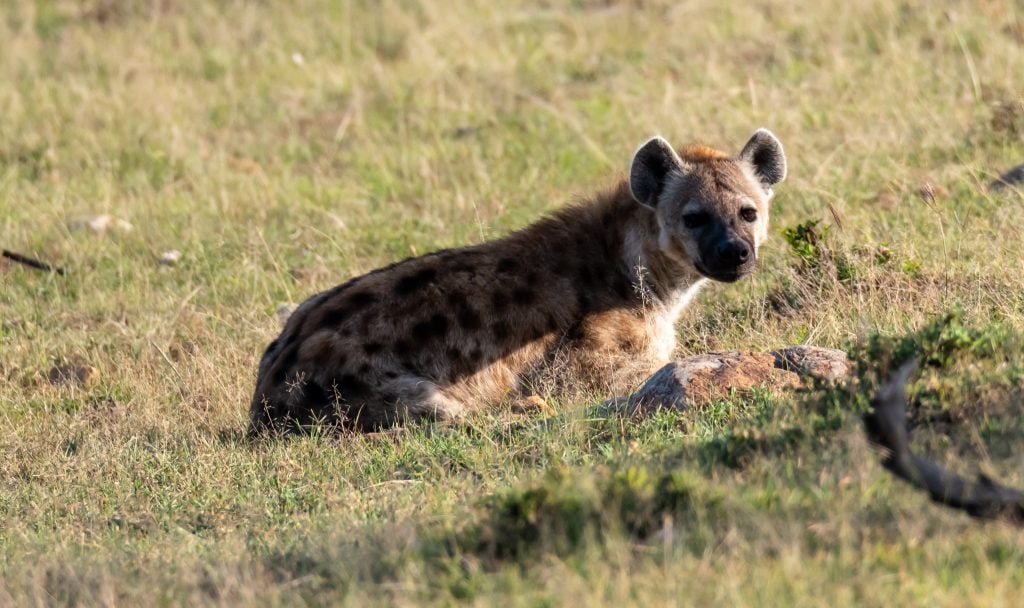

After lunch we reviewed the results of our work: over twelve days our group made 944 observations, spent 148 hours collecting data and had a total count of 5346 animals and 28 mammal species. These data will help the conservancy to determine the wildlife carrying-capacity for the grassland in conjunction with the rangeland and cows. The goal is to balance the needs of the herders while at the same time providing a protected environment where wildlife can also graze and prosper.
Tomorrow we all drive back to Nairobi and then on to our respective destinations, knowing that we helped to make a small difference in the frontline of conservation in the Mara ecosystem.
Our final sunset at Enonkishu wasn’t too shabby either.
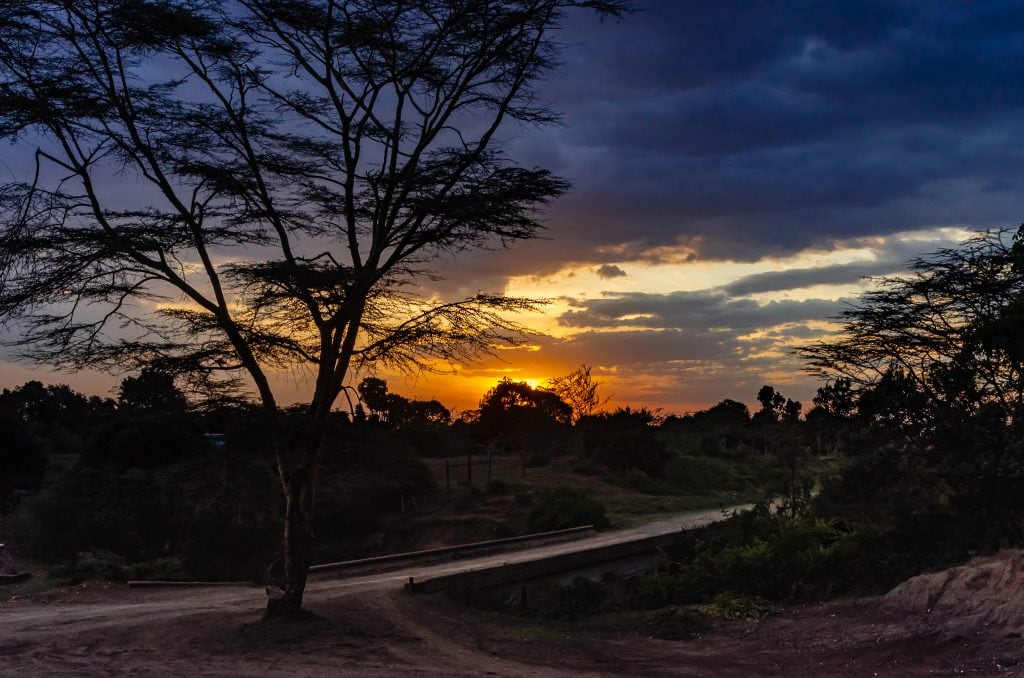
What I liked about this wildlife conservation volunteering experience:
- I really liked having the opportunity to view the wildlife in settings that are not normally part of a typical game drive safari experience: doing a walking transect, taking part in the waterhole observation study and the nighttime drive were all unique experiences I will never forget.
- I honestly really enjoyed my tent accommodations. The bed was extremely comfortable and the comforter quite warm. It was soothing falling asleep every night to the clear sounds of the frogs and insects (and an occasional hippo grunt). I actually got some of the best sleep I have had in a long time.
- I appreciated having the opportunity to get to know the rangers, Musa the Enonkishu operations manager and Leonard, our Kenyan intern. Through them, I got a broader glimpse into the modern Maasai culture beyond the typical village visit that you get on a safari.

- I was humbled at the opportunity to visit the Emarti School and to interact with the students. For these young people, getting this education is a privilege that they truly seem to value and appreciate. For many of their families, paying for this education is also a financial hardship.
- Coming from previous experience with Lean Manufacturing Practices, I really appreciated how organized the training and materials were. There were handy standard operating procedures for each task, as well as lists of equipment needed for each type of animal viewing activity. The location for all materials and supplies were also clearly labeled which always made it easy to find the supplies we needed.
What I struggled with:
- I am not and never have been a morning person. I readily admit that the daily 6AM starts were a challenge for me, but that is when the animals are out and about. Once I got going, seeing the wildlife made up for feeling tired.
- The roads are rough which I expected. Still, getting bumped around while standing in the cage on top of the truck got old. But again, seeing all the wildlife made up for that discomfort.
- All Biosphere Expeditions serve vegetarian food in keeping with their conservation philosophy. The vegetarian food was quite good and the cooks did a great job giving us a wide variety to choose from, including home made ice cream and cake for dessert. But I will admit that by the end of the twelve days, I was really craving a cheeseburger.

Final Thoughts About My Wildlife Conservation Holidays
Biosphere Expeditions makes it very clear in their program description that this is not a game safari experience. (If you are interested in reading about my typical African safari trips please read here). This program is first and foremost about collecting data. There were many photo opportunities that I missed because I was taking a measurement first and by the time I picked up the camera, the moment was gone. However, I had the chance to experience this diverse wildlife in ways that would never have been possible on a typical game drive safari trip.
A few of the program participants combined the best of both worlds. After the Biospheres Expedition program ended, they took an additional few days of safari touring in the parks around Southern Kenya, leaving from Nairobi. Alternatively, you could extend your visit in the area with a luxurious safari stay at the House in the Wild which is also located in the Enonkishu Conservancy.
To see more of my wildlife photos from Enonkishu, please check out 25 Photos to Inspire You to Visit the Enonkishu Conservancy in Kenya
For up to date information on citizen science programs with Biosphere Expeditions, please visit https://www.biosphere-expeditions.org/.
The Kenya program can be found at www.biosphere-expeditions.org/kenya.
Please note that I was a guest of Biosphere Expeditions on my trip to Kenya. All content is my own.
For other inspiring ideas for volunteer travel, check out the GoNomad volunteer travel articles.
Thanks for visiting.
Rose
Pin this!

